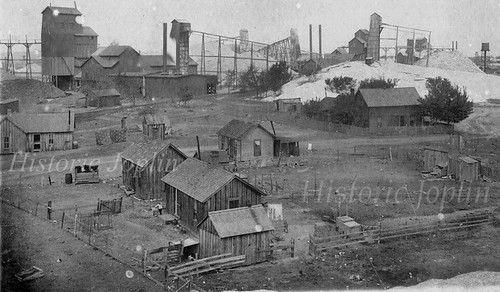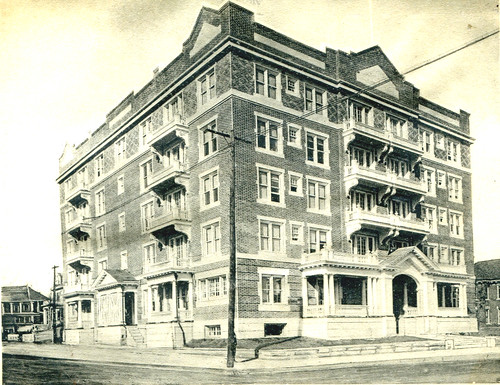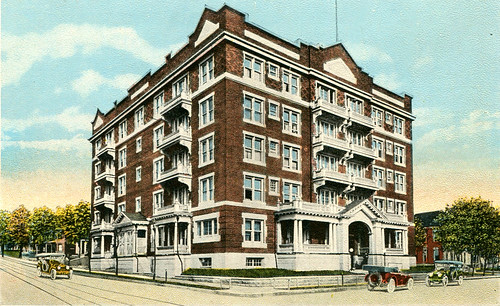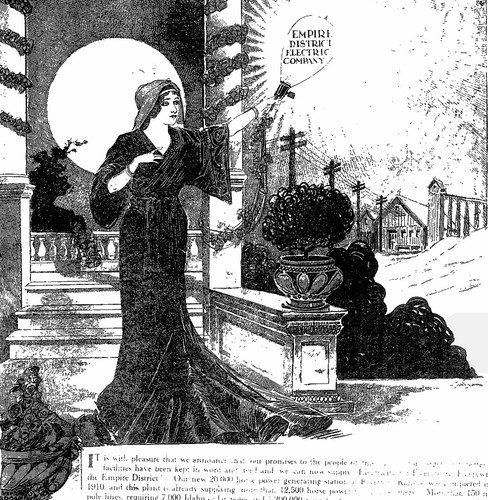One of the more luxurious apartment buildings in Joplin’s early history were the Olivia Apartments. The building was built in 1906 by Dieter and Wenzel construction firm on plans designed by one of Joplin’s widely used architects, Austin Allen. The man footing the $150,000 bill was Anton E. Bendelari, who had made his fortune in mining. The building was named for his daughter, Olivia. We’ll offer a more detailed history of the Olivia in the future, but for now here’s a look at the building’s past and its present (August 2010). As you may notice, while a survivor of over a 100 years, the Olivia has lost some of her exterior features.
Your Local Power Company
As Empire District Electric Company trucks and employees tirelessly work to repair downed lines and restore power throughout Joplin, they are carrying on a long tradition of service to the community. Since 1909, the company has provided power to Joplin for over a century. Below is an ad from the company’s earlier days when electricity was still a technological marvel and a convenience that many eagerly sought.
Source: Joplin Daily Globe
The Interurban
Only relics, rusting pieces of steel, and the rare preserved object remain of the great interurban railway that once connected the cities and towns of the Tri-State area. While we intend to go much further into depth on the railway, for now we’re going to provide a glimpse of it. Below is a map from 1911 showing the steel web of connections of the Southwest Missouri Railway.
An article from the Joplin News Herald proudly boasted that the railway was one of the first of its kind, beginning service in 1893 with a 10 mile long connection between Joplin, Cartersville, Webb City and Prosperity. Nearly two decades later, the railway had accumulated 75 miles of track and was accessible to over a 100,000 residents of the area. In 1894, the railway was used by 400,000 travelers, a number that grew to an astronomical 8,000,000 by 1910.
Initially served by small cars, like the one pictured below, by 1911, larger trolleys were in service powered by four 50 horsepower engines. Cars ran every half hour between the towns with the exception of Joplin to Carterville, 15 minutes, and Joplin to Webb City, every 10 minutes. The costs ran anywhere from 1 penny to 1 1/2 cents per mile. A very low and reasonable rate, the article in the News Herald added.
Source: Joplin News Herald, 1911
“Young Men Are Dying” – Frances Perkins’ visit to Joplin
On April 23, 1940, a crowd of two hundred people stood on the train platform at Joplin’s Frisco Depot, awaiting the arrival of an important visitor to the city. Many of them would have identified themselves as union representatives, but their visitor was not famed labor leader John L. Lewis, head of the United Mine Workers. Instead, when passengers began to disembark from the train, the individual who captured the crowd’s attention was a woman, often described by her contemporaries as “plain,” perhaps even ordinary looking. Plain and ordinary she was not. Frances Perkins, U.S. Secretary of Labor, was the first woman appointed to a position in the U.S. Cabinet. In response to the epidemic of “miner’s lung” in the Tri-State Mining District, Perkins convened a conference known as the Tri -State Silicosis Conference to allow concerned citizens, representatives from mining companies, government officials, and union representatives to discuss the issue.
Among those waiting at the platform to greet Perkins were Evan Just, secretary of the Tri-State Zinc and Lead Ore Producers Association; Frank Evans, president of the association; and the Reverend Cliff Titus, representing the Joplin Chamber of Commerce. Perkins then headed to the Connor Hotel where she stayed during the duration of the conference. She held a five minute press conference in which she stated that the purpose of her visit “is because you have silicosis there, and the labor department is concerned in preventing and correcting conditions due to silicosis.” After the press conference concluded, Secretary Perkins then headed outside to board a specially chartered bus. Together she and thirty other individuals representing various interests toured the mining district. Traveling out of Joplin on Route 66, she sat at the front of the bus with Tony McTeer, the district CIO president, and Evan Just. While driving past squalid miner’s shanties, Secretary Perkins remarked that something needed to be done to help those living in such dire circumstances.
The first stop was at the St. Louis Refining and Smelting Company’s Ballard Mine near Baxter Springs, Kansas. Secretary Perkins donned a “miner’s metal hat, raincoat, and overshoes” before she descended 350 feet into the mine where she then watched demonstrations of different mining methods. She was reportedly very interested in the “methods used by miners in drilling and in a dust control demonstration” given by Fred Netzeband, air hygiene engineer of the Tri-State Zinc and Lead Ore Producers Association. Secretary Perkins was later quoted by an observer as saying, “The world should know the true picture of methods being used in controlling and eliminating dust in the mines.”
After the demonstration, she then met with several of the miners, shook their hands, and listened to their views of the different methods used to control dust. Perkins was accompanied twenty other interested individuals, including Episcopal Bishop William Scarlett of St. Louis; the Reverend Charles Wilson of St. Mark’s Episcopal Church in St. Louis; and Miss Elizabeth Wade White of New York. All three were members of the Tri-State Survey Committee. It was perhaps the one and only time that a bishop of any religious denomination toured one of the Tri-State District’s mines.
Secretary Perkins then visited Treece, Kansas, and Hockerville and Picher, Oklahoma to view housing conditions. In Treece, she visited the home of Mr. and Mrs. William Hannon. Hannon and two other former miners told Perkins that they suffering from silicosis and were unable to receive treatment. Hannon’s wife and four children also reportedly suffered from silicosis. She then met with six women, described as the widows of miners, who stated that they and their children were plagued by silicosis. Secretary Perkins’ bus did not stop in Hockerville and Picher, but she was reportedly able to view “slum conditions” in all three towns from her bus seat. She then returned to the Connor Hotel and prepared for the conference which began at 2 o’clock in the afternoon. The conference itself was held on the roof of the Connor.
The conference revealed a variety of attitudes. After making her opening remarks, Secretary Perkins was followed by the Reverend Cliff Titus. Titus, appearing as a “representative of the public,” declared that workers in the Tri-State Mining District were all white, not foreigners; and that “they are independent and prefer to choose their own methods of living.” He then continued “Many of our people prefer to live near chat piles because they want to spend their money on other things” like cars. But Titus acknowledged that “people of the district are willing and anxious to bring about better living conditions in the mine sections and will co-operate with state and federal agencies.”
Evan Just, secretary of the Tri-State Zinc and Lead Ore Producers Association, spoke on behalf of a majority of mine operators. He declared that operators had made great strides in reducing silicosis over the last several years. Just cited statistics that allegedly showed that incidences of silicosis in miners had been reduced from 60 percent in 1913 to 22 percent in 1929. Further progress, he claimed, had been in the years since. What Just failed to mention, however, is that this only applied to the large mining companies who could afford modern mining equipment, and not the smaller independent operators who could not. Just, however, denied that individuals could contract silicosis from surface dust.

Miner shacks from the turn of the century - the condition of miners' homes continued to be poor decades later.
He then addressed living conditions in the Tri-State Mining District by stating that slum conditions were the result of social problems. “That many people who can afford better homes prefer to live in small, unpainted two and three-room shacks and spend their surplus funds on automobiles and radios cannot be charged against the mining industry,” Just maintained, although he claimed the mining industry did want to eliminate squalid living conditions. He was followed by representatives from federal and state public health, relief, and labor agencies. Even former Joplin resident Mrs. Emily Newell Blair, the noted political activist, was in attendance. Notably, former miner and the district CIO president, Tony McTeer, spoke in the interests of miners. He said, in part:
“Madam Secretary, ladies and gentlemen, conferences as such are not new to you, and to many people it is the usual approach to a problem, to sit down with all interested parties and discuss what is wrong in order to agree on a remedy. I can frankly tell you that a conference of this sort is new and different to the working people of the Tri-State area…
Some people believe that because the miners have not made a lot of noise about their troubles, because of the ignorance of themselves and others, that the workers have no troubles. That is not correct.
I am proud of our miners here. They know they have troubles aplenty, and what they are, but they also know false hopes when they see them. They have been fooled too often, so that now they don’t let themselves in for another deception.
However, they also know a good beginning when they see it. And this conference was received by the people of the Tri-State with great hope and anticipation of beneficial results…
We appreciate your coming this long distance, knowing that you would be convinced that here lies a serious problem.
Young men are dying. Ailing mothers and sick little children arouse in you the interest you have shown by being here today. Our district has the greatest percentage of widowhood in the United States; a sad commentary. These are the things that must be stopped for the future welfare of all the citizens who live here.
The problem as we see it is threefold. First, dust control; second, proper hospital facilities; third, adequate housing.
To reduce the high death rate among the miners requires better dust control and better working conditions in the mines. Stopping silicosis is one step in the direction of curbing the infection of tuberculosis. Mines today go in for more mechanical equipment, as we are living in a world of progress. I haven’t myself worked in a mine for the last five years, but the mining conditions and the health of the miners are my business. Our people working in the mines today give many exact reports of what does on in the mines.
It is said that wet drilling has solved the problem of dust control.
There have been two general fields of mining in this district. First, what we term the old country, which is the Joplin, Webb City area. Second, the Oklahoma and Kansas mining district. In the Joplin district the drilling was done with the piston machine or dry drills. The water liner drilling machine was introduced into Oklahoma and Kansas fields in 1916 or 1917, and from around that period it has been used exclusively. I wish to speak from my own experiences on this. I have never worked in mines except where water-lined drills were used, and I have silicosis, or dust on my lungs. We can produce the names of hundreds of men who have never worked except under wet drilling conditions, and we have buried a great many of them. I have prepared a list of some of those men who I know have died. I am turning it, with my statement, over to the chairman of this meeting.
Since wet drilling alone does not solve the problem, the problem still is dust control. We must get at the root of the problem…”
At the end of the conference, the Tri-State Survey Committee of New York sponsored a showing of “Men and Dust,” a short documentary film by noted photographer Sheldon Dick. Dick had journeyed to the Tri-State Mining District to illustrate the impact of silicosis on the lives of area miners and their families. It was Dick who famously dubbed Treece, Kansas’s Main Street as the “street of walking death.” An estimated one hundred people stayed to watch the film in the Connor Hotel’s Empire Room. Evan Just decried the sixteen and a half minute film as a “smear campaign” against the mining district and the companies that operated there.
After twelve hours, Secretary Perkins was scheduled to leave Joplin to return east. She announced that she would “appoint in the near future a committee of representatives of the three states to explore the possibilities of perfecting a ‘state compact agreement’ for coordinating the work of concerned authorities and agencies.”
Before leaving, she spoke to a crowd of 700 to 800 people at an open labor meeting sponsored by the International Union of Mine, Mill, and Smelter Workers and the American Federation of Labor. Her speech focused on the need to improve housing and living conditions in the mining district. After concluding her remarks, Secretary Perkins then left to catch her train.
As David Rosner and Gerald Markowitz point out in their book, Deadly Dust, the issue of silicosis faded away because of the lack of a strong labor movement to press for better working and living conditions, and the subsequent collapse of the mining industry in the Tri-State region. After the death of FDR, subsequent administrations had little concern for miner’s lung. But for a brief period of time, Joplin and the rest of mining district captured the attention of the nation
Sources:Joplin Globe Deadly Dust: Silicosis and the On-Going Struggle to Protect Workers’ Health by David Rosner and Gerald Markowitz “What You Really Want Is an Autopsy”: Frances Perkins and the U. S. Government Conference in Joplin, Missouri, 1940 http://historymatters.gmu.edu/d/128/
What the Train Brings In
Any town with a railroad was bound to have its share of characters. Joplin certainly had its share. In 1897, Arthur Harrold, an eighteen year old tramp, arrived in town with a curious collection of artifacts. Harrold told a Globe reporter that he hailed from New York City and had left the Big Apple eight years and ten months earlier to see the country. With him he carried a sack full of relics that rivaled the collection of the Smithsonian: fragments of rope used to hang Cherokee Bill; a petrified potato; spectacles given to him by the first settler of Texas; the bullet that killed General James McPherson; cartridges owned by Cherokee Bill and one of the Dalton boys; saws used by Noble Shepherd when he cut his way out of the St. Louis city jail; and letters from officials from all over the country certifying his presence in their cities.
Harrold’s journey was sparked by a wager that he could not travel 65,000 miles in a ten year period and save up $6,000. At the time of his arrival in Joplin, he had reportedly saved $5,382 that was deposited in a New York bank. As part of the wager, he was not allowed to beg, steal, or borrow on his journey. Should he fulfill his mission, Harrold was to receive $5,000 from the Police Gazette magazine plus $5,000 from New York World and Associated Press.
At around the same time, another character drifted into Joplin, but not one that the police wanted to see. “Kansas City Jack” was described as a “bum” who was not “meek.” Upon arriving in Joplin, Jack immediately raised a disturbance at one of the train depots. Officer Jack Winters was called and quickly collared Kansas City Jack. But the bum was not one to go quietly as it was a “continual fight all the way from the depot to the station house.” In the course of their journey, the officer knocked Jack down “about twenty times and was about tuckered out when he reached the jail.” His neat, clean police uniform was reduced to shreds as the officer arrived at the police station wearing “only a pair of shoes and a tired looking countenance.” This, according to the Globe, was “the sort of struggle every officer is reported to have who arrests Kansas City Jack.”
After he was processed and released, Jack did not stay out of trouble. At two o’clock in the afternoon, Deputy Marshal Fones discovered some bums were passing liquor through the jail window to prisoners inside the jail. Upon going outside, Fones found that Kansas City Jack was one of the main culprits. After a struggle, and Deputy Marshal Fone’s pants being destroyed in the process, Jack was back in jail.
If Fones expected the rest of the day to go smoothly, he was wrong. At five o’clock that afternoon, while Fones was talking to a friend on Main Street between Second and Third streets, a little boy named Ira Chubb ran up and told him that prisoners were escaping from the city jail. Fones, together with Officer Winters and Deputy Constable Hopkins, took off in hot pursuit. Their chase was made all the easier by a group of young boys who were following the escapees. The prisoners were captured at Third and Byers. Upon inspecting the jail, it was discovered that one of the prisoners was a “mechanical genius” who had managed to unlock the jail door using only a simple wire.
There was never a dull moment in early Joplin!
Joplin’s Mining Queen
“All Joplinites who remember the palmy days of ’90, ’91, and ’92 will call to mind the exciting scenes and incidents of those times, and the prominent actors then upon the stage, which made this city the talk of the country,” the Globe recalled in 1897, upon learning that Mrs. M.C. Allen was to be committed to the state insane asylum in Nevada, Missouri.
Mrs. M.C. Allen, Joplin’s “Mining Queen,” was a conspicuous figure in local society. In 1889, after divorcing her husband, she arrived in Joplin from Indiana. As part of her alimony agreement she received a one hundred acre tract of land near Blendville. In a short time, she leased the land to Frank, Harry, and John Snyder. Together, the Snyder brothers developed the land into a profitable mining operation. It was reported that in 1890, 1891, and 1892 the Snyders paid Mrs. Allen $42,000 in royalties.
Allen, however, was ambitious. In 1893, she earned the sobriquet “Mining Queen” when she “took possession of the tract herself and operated it successfully for a period of fifteen months, during which time her income from her operations was from $500 to $600 per month.” Allen bore her new nickname with “such regal extravagance as to excite both natives and visitors alike.”
Mrs. Allen began to indulge in the purchase of “blooded horses” and “imported dogs.” She paid for $50 photographic portraits of her dogs, reserved the finest lodgings at local hotels, and began dabbling in wheat speculation with Frank Snyder. But the good times came to an end when the bottom fell out of the wheat market and both Allen and Snyder were financially ruined. Her one hundred acre tract of land was mortgaged in Kansas City for $5,500 and mortgaged a second time in Crawfordsville, Indiana, for an additional $1,800. The mining land was gobbled by investors from Minnesota for a mere pittance. When the dust cleared, Mrs. Allen was left with $1,000.
Dissolute, Allen moved first to Kansas City, then later to St. Louis where she opened a boarding house. But she could not forget her glory days in Joplin and returned, determined to rebuild her fortune. “Sickness and mental troubles” took their toll on Allen, however, brought upon by “the constant brooding over her losses.” Her despair caused her to hallucinate and lash out violently, despite being cared for with “a kindness and sympathy which her unfortunate situation fully justifies.”
It was determined that she should be sent to the state insane asylum at Nevada. When she arrived in Nevada, the Nevada Mail reported the following story:
“A pathetic incident occurred when Mrs. Allen of Joplin was brought to the asylum to be confided. She had been a woman of wealth, which had been dissipated with a lavish hand. Among her acquisitions was an imported dog which had been procured and trained at great expense…When the unfortunate was brought by her friends and an officer to this house of refuge for the mentally afflicted, her faithful dog accompanied the party.
She did not want to depart from her canine companion, and the mute appeal of the dumb animal to be permitted to stay with her was touching. [Asylum] Superintendent Robinson’s kind heart was moved…he permitted the little fellow to become an inmate and it occupies the room with its mistress, as faithful in companionship, loyal in love, and devoted to his friend as in the days of her luxury and social prominence…”
Thus was the end of Joplin’s first “Mining Queen.”
Check Out Views of the Asylum here.
A Joplin Football Outing
By the 1890’s, both Joplin and Carthage had been bit by the football bug. Naturally, the two engaged in an intercity rivalry with teams from one traveling to play the other. In the above, the Joplin team has engaged a “four horse tallyho” to carry them to the proverbial battle ground, a field located on the east side of Main Street between Sixteenth and Seventeenth Streets. It was known as the Joplin Bicycle Track. It’s unknown if the local boys won the match, but we’ll just assume so. After all, their opponents WERE from CARTHAGE.
Source: Joplin Daily Globe.




















